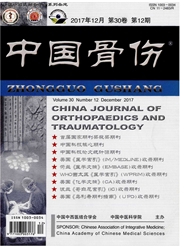

 中文摘要:
中文摘要:
骨质疏松性骨折是骨质疏松症最具破坏性的结局,多个相互作用的危险因素对其发生有一定的影响。人在40岁之后,随着年龄的增长,身体的机能开始逐渐衰退,开始出现如腰酸、背痛、下肢抽筋、乏力等症状,这些症状与肾虚、肝虚、脾虚、血瘀等中医证候要素之间存在一定的关联性,而这些症状的出现可能对骨折的发生有一定的早期提示作用。现有的骨质疏松性骨折风险评估工具多是基于现代医学危险因素开发而成,缺乏骨质疏松性骨折证候学方面的研究内容,在实际应用中存在一定的局限。如果在预测工具中融入中医证候的相关研究内容,建立符合我国人口学特征的骨质疏松性骨折风险评估模型,必将有助于提高风险评估工具对骨质疏松性骨折高危人群的风险评估准确性。
 英文摘要:
英文摘要:
Osteoporotic fracture is the most destructive ending of osteoporosis ,many interacting risk factors play a role in its occurrence. With age,the bodies function decline gradually. Symptoms like soreness of the waist,back pain,cramp of the lower limb and weakness appears. These are related to TCM syndrome factors like kidney deficiency ,liver deficiency,spleen deficiency and blood stagnation. Symptoms can act as a warning of the occurrence of osteoporotic fracture in the early stages. The risk assessment tool of osteoporotic fracture is mostly developed on the basis of modern risk factors and thus lacks syn-drome differentiation,that may limit its utilization. If the relevant content of syndrome differentiation is integrated into the fore-casting tool and a risk assessment tool of osteoporotic fracture which complies with the demographics of China is built up ,pop-ulation risk assessment for high of risk could be established and scientific evidence for the adoption of effective interventions could be applied.
 同期刊论文项目
同期刊论文项目
 同项目期刊论文
同项目期刊论文
 Variable selection using the optimal ROC curve: An application to a Traditional Chinese Medicine stu
Variable selection using the optimal ROC curve: An application to a Traditional Chinese Medicine stu 期刊信息
期刊信息
